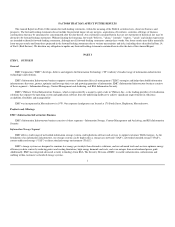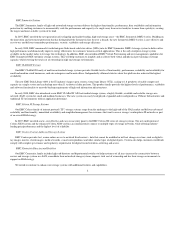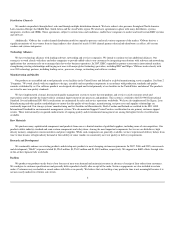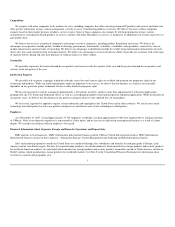EMC 2007 Annual Report Download - page 15
Download and view the complete annual report
Please find page 15 of the 2007 EMC annual report below. You can navigate through the pages in the report by either clicking on the pages listed below, or by using the keyword search tool below to find specific information within the annual report.
the difficulty and cost of integrating the acquired business, including costs and delays in implementing common systems and procedures and
costs and delays caused by communication difficulties or geographic distances between the two companies' sites;
the assumption of liabilities of the acquired business, including litigation-related liability;
the potential impairment of acquired assets;
the lack of experience in new markets, products or technologies or the initial dependence on unfamiliar supply or distribution partners;
the diversion of our management's attention from other business concerns;
the impairment of relationships with customers or suppliers of the acquired business or our customers or suppliers;
the potential loss of key employees of the acquired company; and
the potential incompatibility of business cultures
These factors could have a material adverse effect on our business, results of operations or financial condition. To the extent that we issue shares of our
common stock or other rights to purchase our common stock in connection with any future acquisition, existing shareholders may experience dilution.
Additionally, regardless of the form of consideration issued, acquisitions could negatively impact our net income and our earnings per share.
In addition to the risks commonly encountered in the acquisition of a business as described above, we may also experience risks relating to the challenges
and costs of closing a transaction. Further, the risks described above may be exacerbated as a result of managing multiple acquisitions at the same time.
In 2007, the Financial Accounting Standards Board issued Statement of Financial Accounting Standards No. 141(R) "Business Combinations." The
standard, which is effective commencing in our 2009 fiscal year, will result in significant changes in accounting for acquisitions. Depending upon the number
of and magnitude of acquisitions which we may consummate in 2009, the standard could have a material adverse effect on our business, results of operations
and financial condition.
We also seek to invest in businesses that offer complementary products, services or technologies. These investments are accompanied by risks similar to
those encountered in an acquisition of a business.
We may be unable to keep pace with rapid industry, technological and market changes.
The markets in which we compete are characterized by rapid technological change, frequent new product introductions, evolving industry standards and
changing needs of customers. There can be no assurance that our existing products will be properly positioned in the market or that we will be able to
introduce new or enhanced products into the market on a timely basis, or at all. We spend a considerable amount of money on research and development and
introduce new products from time to time. There can be no assurance that enhancements to existing products and solutions or new products and solutions will
receive customer acceptance. As competition in the IT industry increases, it may become increasingly difficult for us to maintain a technological advantage
and to leverage that advantage toward increased revenues and profits.
Risks associated with the development and introduction of new products include delays in development and changes in data storage, networking
virtualization, infrastructure management, information security and operating system technologies which could require us to modify existing products. Risks
inherent in the transition to new products include:
the difficulty in forecasting customer preferences or demand accurately
the inability to expand production capacity to meet demand for new products
the impact of customers' demand for new products on the products being replaced, thereby causing a decline in sales of existing products and an
excessive, obsolete supply of inventory
delays in initial shipments of new products
Further risks inherent in new product introductions include the uncertainty of price-performance relative to products of competitors, competitors'
responses to the introductions and the desire by customers to evaluate new products for extended periods of time. Our failure to introduce new or enhanced
products on a timely basis, keep pace with rapid industry, technological or market changes or effectively manage the transitions to new products or new
technologies could have a material adverse effect on our business, results of operations or financial condition.
The markets we serve are highly competitive and we may be unable to compete effectively.
We compete with many companies in the markets we serve, certain of which offer a broad spectrum of IT products and services and others which offer
specific information storage, management or virtualization products or services. Some of these companies (whether independently or by establishing
alliances) may have substantially greater financial, marketing and technological resources, larger distribution capabilities, earlier access to customers and
greater opportunity to address customers' various IT requirements than us. In addition, as the IT industry consolidates, companies may improve their
competitive position and ability
11
•
•
•
•
•
•
•
•
•
•
•
•
























